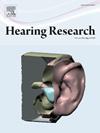术前磁共振成像、视听言语感知和情绪与语后聋成人的人工耳蜗植入效果有关
IF 2.5
2区 医学
Q1 AUDIOLOGY & SPEECH-LANGUAGE PATHOLOGY
引用次数: 0
摘要
获得性重度到重度听力损失是我国老龄化人口日益严峻的问题。人工耳蜗植入(CI)是治疗这种高级感觉剥夺的金标准。尽管CI的总体结果令人满意,但仍有相当数量的患者表现出不满意的结果。本研究旨在通过整合术前MRI和行为数据来改进目前CI结果的预测模型。我们获得了3D T1 MRI来测量皮质厚度(CT)和体积,使用基于表面的分析和脑组图谱的包裹。植入后6个月的CI成功,通过视听语音感知测量,与术前使用助听器的语音和视听感知以及残余听力,特别是未植入耳侧的残余听力相关。此外,CI结果与左侧颞上回及沟、左侧额下区、双侧额上区CT呈正相关。左侧额叶中回和顶叶区域的体积,特别是左侧,也与CI结果相关。线性回归模型显示,术前视听言语感知、残余听力、抑郁和CT测量相结合,可以最好地预测CI结果。我们的研究结果强调了保留与听力、语言、视听整合和认知功能有关的大脑区域对CI成功的重要性。此外,脑MRI结合其他预测因素可以帮助识别可能需要更多时间来适应CI的患者,从而允许更有针对性的康复,并可能获得更大的疗效。本文章由计算机程序翻译,如有差异,请以英文原文为准。
Preoperative MRI, audiovisual speech perception, and mood are associated with cochlear implant outcomes in adults with postlingual deafness
Acquired severe to profound hearing loss is an increasingly challenging problem of our aging population. Cochlear implantation (CI) is the gold standard treatment for this advanced form of sensory deprivation. Despite the overall satisfactory results of CI, a substantial number of patients show unsatisfactory outcomes. This study aims to improve current predictive models of CI outcome by integrating preoperative MRI with behavioral data. We acquired a 3D T1 MRI to measure cortical thickness (CT) and volume using surface-based analysis and parcellation from the Brainnetome atlas. CI success at 6 months post-implant, as measured by audiovisual speech perception, was correlated with preoperative speech and audiovisual perception with hearing aids, and residual hearing, especially at the side of the non-implanted ear. In addition, CI outcome correlated positively with CT of the left superior temporal gyrus and sulcus, left inferior frontal region, and bilateral superior frontal regions. The volume of the left middle frontal gyrus and regions of the parietal lobe, especially at the left side, also correlated with CI outcome. Linear regression models revealed that CI outcome was best predicted by the combination of preoperative measures of audiovisual speech perception, residual hearing, depression and CT. Our results highlight the importance of preserved brain areas implicated in hearing, language, audiovisual integration, and cognitive functions for CI success. Furthermore, brain MRI in conjunction with other predictors can help to identify patients who may need more time to adjust to the CI, allowing a more tailored rehabilitation, and potentially greater efficacy.
求助全文
通过发布文献求助,成功后即可免费获取论文全文。
去求助
来源期刊

Hearing Research
医学-耳鼻喉科学
CiteScore
5.30
自引率
14.30%
发文量
163
审稿时长
75 days
期刊介绍:
The aim of the journal is to provide a forum for papers concerned with basic peripheral and central auditory mechanisms. Emphasis is on experimental and clinical studies, but theoretical and methodological papers will also be considered. The journal publishes original research papers, review and mini- review articles, rapid communications, method/protocol and perspective articles.
Papers submitted should deal with auditory anatomy, physiology, psychophysics, imaging, modeling and behavioural studies in animals and humans, as well as hearing aids and cochlear implants. Papers dealing with the vestibular system are also considered for publication. Papers on comparative aspects of hearing and on effects of drugs and environmental contaminants on hearing function will also be considered. Clinical papers will be accepted when they contribute to the understanding of normal and pathological hearing functions.
 求助内容:
求助内容: 应助结果提醒方式:
应助结果提醒方式:


